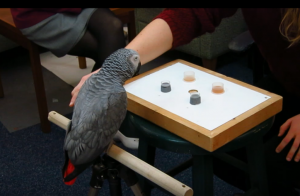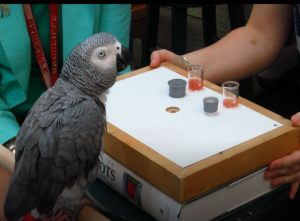Contents

Understanding Piagetian liquid conservation — that the amount of a liquid is the same (is conserved) even after it is transferred to a different type of container — is a difficult task for children because it not only requires them to recognize this consistency, but also to ignore perceptual information to the contrary; that is, that after manipulation, the amount of liquid may look like more or less. Some children do not understand the concept until they are about 8 years old (Piaget & Inhelder, 1966/1969). In a previous blog, I described how we gave this test to four African grey parrots — my own Griffin and Athena, plus Pepper and Franco, owned by the Hartsfields, who had worked in our lab. All four birds succeeded, showing that they understood this difficult concept (Pepperberg et al., 2017).
My colleagues who read the paper, however, wondered how the parrots would fare when compared to various species of great apes on a related task — that of ‘”overconservation.” Here, instead of starting with equal quantities in two glasses that are then poured into new containers that are differently shaped from one another, the experimenter starts with different amounts and tests whether the subjects can track the larger amount after various transformations. Piaget didn’t like this test very much; he argued that a subject could simply track more versus less and that it is the act of being confronted with a confusing perceptual change that causes nonconservers to fail. However, several researchers (Muncer, 1983; Suda & Call, 2004) came up with variations that they claimed would counter these objections. We, therefore, thought it would be interesting to give their tests to our birds (Cornero et al., 2019).

Tracking Liquid Transfers
Our Experiment 1 had four different types of trials, just to test how well the birds could track transfers; the order in which birds were given the trials was random.
In one-quarter of the trials, initial and destination containers — small plastic tattoo cups — were identical for what we called “clear” transfers; we simultaneously transferred the juices directly, so that what was on the right side initially stayed on the right side. These trials simply tested whether the birds would reliably choose the greater amount of liquid — organic juices that they really adored.
In another quarter of the trials, we performed direct transfers but covered the sides of the destination containers in duct tape — what we called “opaque” transfers; these trials tested whether the birds could track the transfer even when they couldn’t see the final amounts.
In the remaining trials, we repeated the direct and opaque conditions, but here we performed diagonal transfers — the experimenter crossed her hands as she simultaneously poured the juices, so that the quantity on the right ended up on the left. These trials really tested how well the birds could track the transfers, by controlling for the birds simply choosing the same side that had initially had the most juice.
All four parrots chose the larger quantity of juice with very high accuracy on all task permutations, and on the simplest trials they were usually at 100%. All ape species tested (bonobo, chimpanzee, orangutan) by Suda and Call (2004) also chose the larger quantity statistically more often than expected by chance when transfers were direct. And all apes scored at the same levels as parrots on the clear transfers (90 to 100%); however, only the orangutans matched the parrots’ accuracy on the opaque trials (80 to 100%). What was really surprising, however, was that only the orangutans were challenged with diagonal transfers, and only one of four given that task succeeded (Call & Rochat, 1997); in contrast, all the parrots did well (80 to 100%).
Tracking Liquid Conservation
Experiment 1, of course, did not even test anything about conservation; to do that we needed a more complicated task — hence Experiment 2. We adapted our procedure from a task used by Muncer (1983), in which destination cups were rigged such that different initial quantities appeared the same after a transformation. Here we placed small disks into the bottom of one of the destination cups, so that both cups appeared full, even though one was not. The bottom halves of both cups were covered in tape to disguise our duplicity. In some trials, the initial cups were clear and in some trials they were opaque, and we again performed direct and diagonal transfers. If the birds were tracking the quantities, they would not be fooled by the perceptual equivalence in destination cups when the initial cups were clear, but should choose randomly when the initial cups were opaque and they didn’t know which cup held more. The opaque trials were a control for any possible cuing on our part. And, again the diagonal trials forced the birds to track the transfer, not simply stick to one side. As before, we intermixed all the trials so that birds had to carefully attend to what was happening.
The parrots’ results were exciting, particularly when compared with the apes’. Only one of two of Muncer’s chimpanzees, Jane, chose the larger quantity at a statistically significant level when she could see — and presumably track — initial quantities but was appropriately at chance when transformations were hidden. Jane, however, was not given diagonal transfers. When the parrots could see transfers, all performed at 90 to 100%. Successful performance could be based only on the inference that quantities do not change during transfer, that the larger amount would still be the larger amount although now no perceptual difference existed, and that the appropriate strategy would be to track that amount. Again, crossed transfers increased the difficulty of that tracking, but did not cause any parrot to fail. In contrast, all birds were appropriately at chance when initial quantities were in opaque cups, a condition that provided no knowledge that an initial difference in quantity existed. These data suggest that Grey parrots’ concept of conservation is at least as strong as that of Muncer’s ape and may, in fact, be stronger because of their success on the diagonal trials (NB: Suda and Call’s subjects were not given these types of trials).
Tracking Liquid Despite Perceptual Confusion
This task, however, did not place perceptual information in strong contrast to inferential information — that is, make what had been a smaller quantity look bigger than the larger quantity. This trick was the basis for Experiment 3. Our procedure was adapted from both Muncer’s (1983) and Suda and Call’s (2004) studies, in that the initial amounts were transferred to differently shaped containers that would present strong perceptual confusion. Here we used two differently sized destination containers and rigged them with various numbers of disks so that although the levels were the same after transfer (they both looked full), the physically larger container could sometimes actually have the lesser amount of juice. We again used clear and opaque initial cups and direct and diagonal transfers.
In clear trials, birds should still track initial quantities and choose the cup with the actual greater amount, whatever the perceptual information, overcoming a possible strong bias for what might look like “more.” In the opaque trials, lacking knowledge of which cup really has more, they should be duped into choosing the cup that appears to have more, or, knowing they did not have adequate information to make a valid choice, choose randomly or demonstrate a side bias (i.e., just grab a favorite side because the choice doesn’t matter and that’s the quickest way to get some juice). Due to circumstances beyond our control, only the Harvard birds were able to participate in Experiment 3. We thus studied one older, more task-experienced male, Griffin, and a younger, more task-inexperienced female, Athena. This time, the two birds performed at somewhat different levels of accuracy; their abilities can be compared with those of some of the apes’.
Griffin’s Experiment 3 Results
Griffin clearly understood conservation. He was not confused by anything he saw in visible transfers. Whether larger amounts appeared smaller or larger after transformation and whether transformations were direct or diagonal, he chose the larger quantity (90% for all tasks). In contrast, when he had no information as to relative sizes of initial quantities, he chose at chance with a significant right-side preference on all trials. Muncer’s subject Jane performed at a similar level on related trials, but she did not have crossed-trial transfers. In Suda and Call’s experiments, none of the apes had a task that rigged destination containers as we did, such that smaller amounts could appear greater overall after transformation. On the tasks they did perform, individual subjects seemingly either preferred one or the other container itself in all types of trials. Interestingly, orangutans were significantly above chance even when they did not see the transformation; here the fuller container always had the larger amount, suggesting that, unlike Griffin, orangutans consistently chose based on perceptual information rather than inference.
Athena’s Experiment 3 Results
Athena’s data are not as straightforward. Notably, in visible transfers, she made only one error when the larger amount of juice was directly transferred to a smaller cup (if she were basing her answer on perceptual information — choosing the apparently larger amount — she could not have succeeded at that level), but she made five mistakes when this transfer involved a diagonal transfer. She even made three mistakes in a diagonal transfer when choice of the larger container would have been correct (i.e., when perceptual and inferential information were consistent with each other). Her likely problem, unlike the apes, was not an issue of being distracted by perceptual information but rather one of having difficulty following transformations when, in this experiment, they involved a diagonal transfer. She did not have any issues with diagonal transfers in Experiments 1 and 2; thus, only the combination of diagonal transfers and the most difficult perceptual distractions appeared to confuse her. Importantly, her data on direct transfers — which were the only types given apes — place her understanding above that of apes. Had we not added the diagonal transfer condition, she would have been considered equally as competent on overconservation tasks as Griffin.
In sum, Grey parrots seem to do as well as children in the 6- to 8-year-old range, and, to some extent, do as well as or outperform the great apes on tasks meant to test Piagetian concepts of conservation. Would the birds be just as accurate if the stimuli involved something like a lump of food that could be squished or shaped? The problem is finding the right food that they could eat in appropriate quantities!
References
Call, J., & Rochat, P. (1997). Perceptual strategies in the estimation of physical quantities by orangutans (Pongo pygmaeus). Journal of Comparative Psychology, 111, 315–329.
Cornero, F. M., Hartsfield, L. A., & Pepperberg, I. M. (2019, December 19). Piagetian liquid overconservation in Grey parrots (Psittacus erithacus). Journal of Comparative Psychology. Advance online publication. http://dx.doi.org/10.1037/com0000209
Muncer, S. J. (1983). “Conservations” with a chimpanzee. Developmental Psychobiology, 16, 1–11.
Pepperberg, I. M., Gray, S. L., Lesser, J. S., & Hartsfield, L. A. (2017). Piagetian liquid conservation in Grey parrots (Psittacus erithacus). Journal of Comparative Psychology, 131, 370–383.
Piaget, J. & Inhelder, B. (1966/1969). The psychology of the child. London: Routledge and Kegan Paul.
Suda, C., & Call, J. (2004). Piagetian liquid conservation in the great apes (Pan paniscus, Pan troglodytes, and Pongo pygmaeus). Journal of Comparative Psychology, 118, 265–279.






Way to go Griffin! I was wondering since Athena didn’t do so well
was it because she’s a younger parrot or could it be female parrots
aren’t as intelligent as the male parrots, or maybe Athena was just
having an off day, so to speak. The study is very interesting Dr.
Pepperburg, as usual.
Male and female parrots have the same capacity for intelligence.
I do not understand why Dr. Pepperberg has not received a MacArthur award.